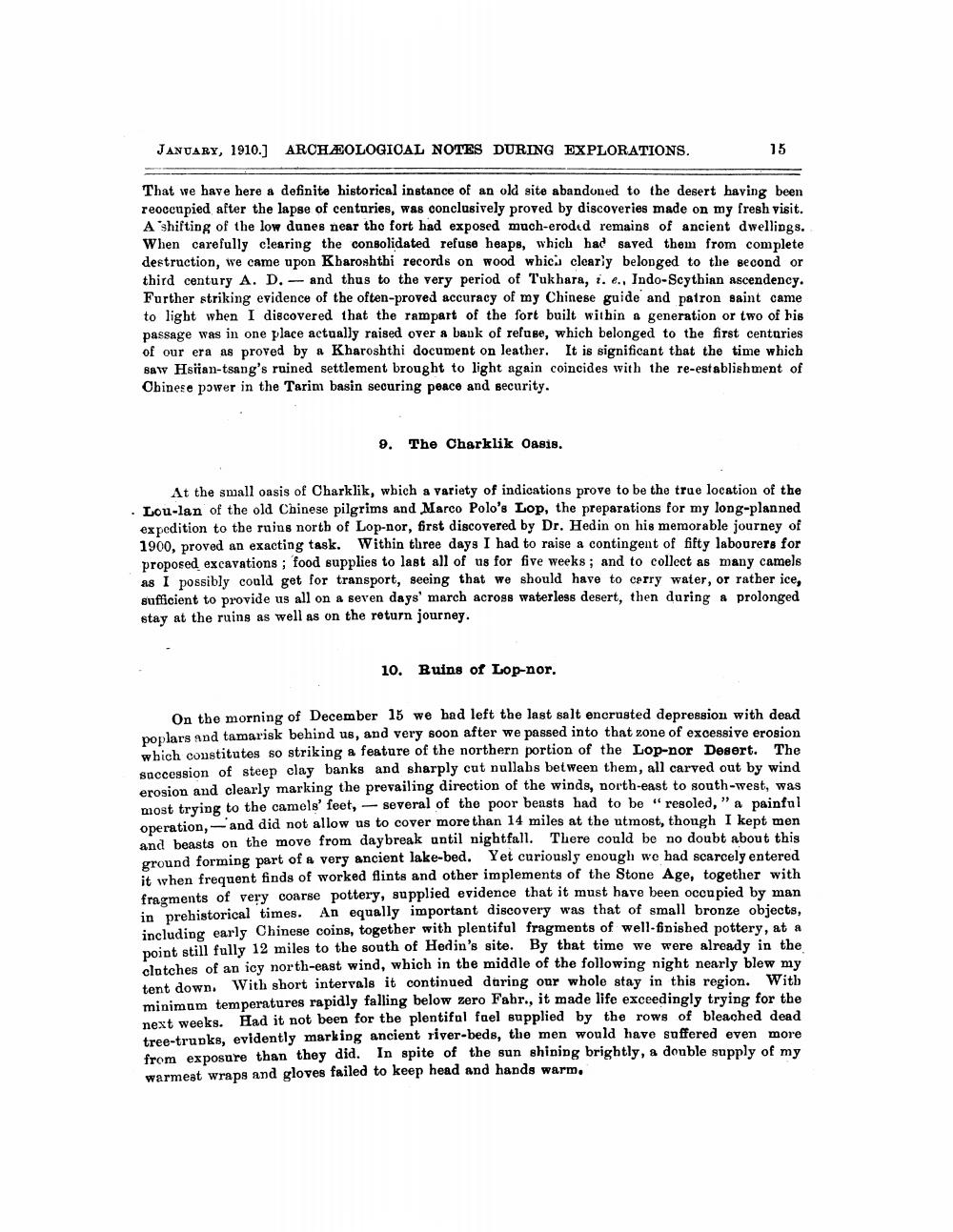________________
JANUARY, 1910.) ARCHÆOLOGICAL NOTES DURING EXPLORATIONS.
15
That we have here a definite historical instance of an old site abandoned to the desert having been reoccupied after the lapse of centuries, was conclusively proved by discoveries made on my fresh visit. A shifting of the low danes near the fort had exposed much-eroded remains of ancient dwellings. When carefully clearing the consolidated refuse heaps, which had saved them from complete destruction, we came upon Kbaroshthi records on wood whici clearly belonged to the second or third century A. D. -- and thus to the very period of Tukhara, i. e., Indo-Scythian ascendency. Further striking evidence of the often-proved accuracy of my Chinese guide and patron saint came to light when I discovered that the rampart of the fort built within a generation or two of his passage was in one place actually raised over a bauk of refuse, which belonged to the first centuries of our era as proved by a Kharoshthi document on leather. It is significant that the time which BAW Hsiian-tsang's ruined settlement brought to light again coincides with the re-establishment of Chinese power in the Tarim basin securing peace and security.
9.
The Charklik Oasis.
At the small oasis of Charklik, which a variety of indications prove to be the true location of the . Lou-lan of the old Chinese pilgrims and Marco Polo's Lop, the preparations for my long-planned expedition to the ruins north of Lop-nor, first discovered by Dr. Hedin on his memorable journey of 1900, proved an exacting task. Within three days I had to raise a contingent of fifty labourers for proposed excavations ; food supplies to last all of us for five weeks; and to collect as many camels as I possibly could get for transport, seeing that we should have to carry water, or rather ice, sufficient to provide us all on a seven days' march across waterless desert, then during a prolonged stay at the ruins as well as on the return journey.
10. Ruins of Lop-nor.
On the morning of December 15 we had left the last salt encrusted depression with dead poplars and tamarisk behind us, and very soon after we passed into that zone of excessive erosion which constitutes so striking a feature of the northern portion of the Lop-nor Desort. The saccogsion of steep clay banks and sharply cut nullabs between them, all carved out by wind erosion and clearly marking the prevailing direction of the winds, north-east to south-west, was most trying to the camels' feet, - several of the poor beasts had to be "resoled," a painful operation, and did not allow us to cover more than 14 miles at the utmost, though I kept men and beasts on the move from daybreak antil nightfall. There could be no doubt about this ground forming part of a very ancient lake-bed. Yet curiously enough we had scarcely entered it when frequent finds of worked flints and other implements of the Stone Age, together with fraoments of very coarse pottery, supplied evidence that it must have been occupied by man in prehistorical times. An equally important discovery was that of small bronze objects, including early Chinese coins, together with plentiful fragments of well-finished pottery, at a point still fully 12 miles to the south of Hedin's site. By that time we were already in the Clutches of an icy north-east wind, which in the middle of the following night nearly blew my tent down. With short intervals it continued during our whole stay in this region. With minimum temperatures rapidly falling below Zero Fahr., it made life exceedingly trying for the next weeks. Had it not been for the plentiful fuel supplied by the rows of bleached dead tree-trupks, evidently marking ancient river-beds, the men would have suffered even more from exposure than they did. In spite of the sun shining brightly, a double supply of my warmest wraps and gloves failed to keep head and hands warm,




